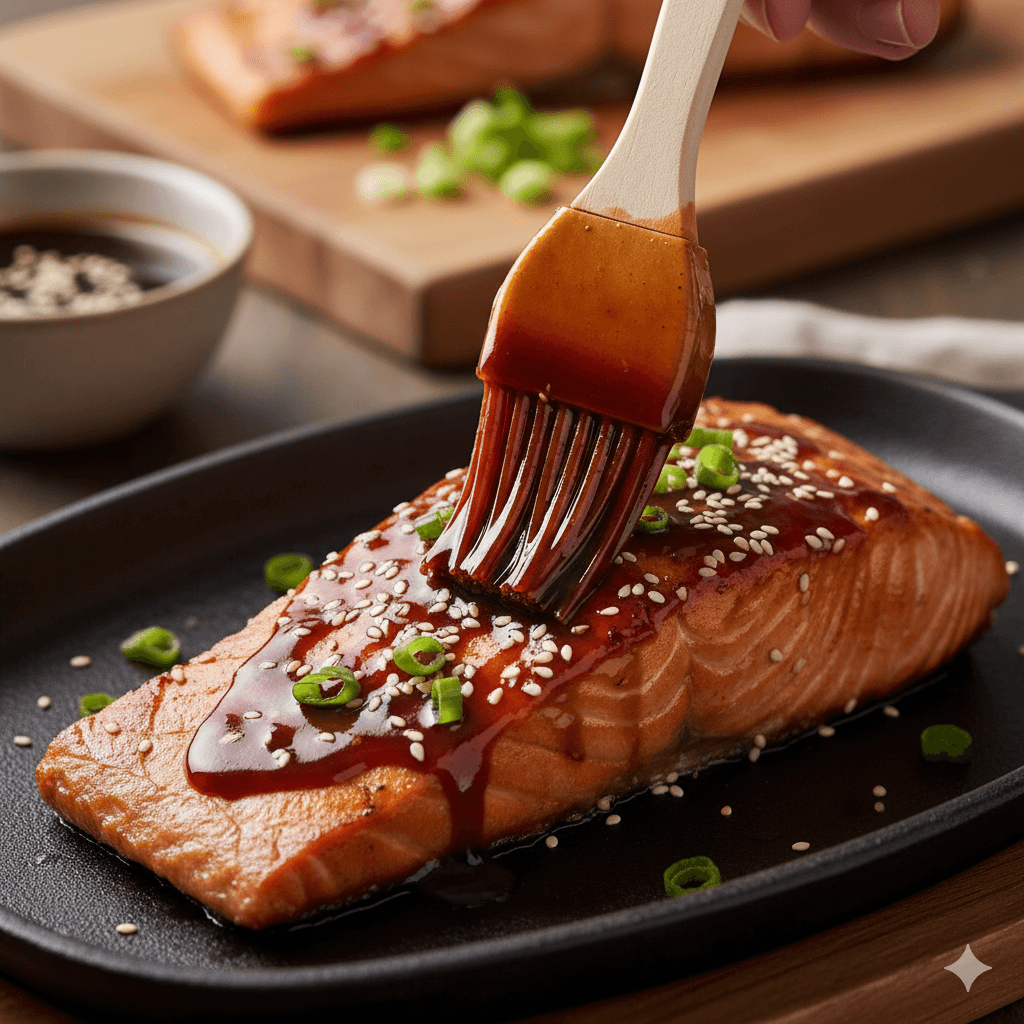
I. Introduction: The Sauce That Means “Shine”
Few Japanese culinary terms are as globally recognizable as Teriyaki. Yet, for most people outside of Japan, “teriyaki” refers not to a cooking method, but to a sweet, sticky, and savory bottled sauce. This distinction is the key to mastering this pillar.
The word Teriyaki is a compound of two Japanese terms: “Teri” (照り), which means shine or luster, and “Yaki” (焼き), meaning grilling or broiling. The technique, developed in the 17th century, focuses on achieving a beautiful, caramelized sheen on food by continuously basting it with a reduced sauce.
This pillar article is your comprehensive guide to both the authentic, traditional tare (glaze) and the popular, savory Americanized version. We will break down the history, the essential ingredients (Soy, Mirin, Sake), and the crucial technique of reduction that turns a simple liquid into a glossy, umami-rich glaze, allowing you to elevate chicken, salmon, beef, and tofu alike.
II. Pillar 1: The Teriyaki Origin — Traditional Japanese Tare
True Teriyaki tare is a minimalist masterwork, emphasizing the natural qualities of a few high-quality, indigenous ingredients.
The History of Teriyaki: Preservation to Popularity
Teriyaki originated in Japan during the Edo period (1603-1868), primarily as a method of preserving and flavoring fish, especially in coastal regions. Japanese immigrants later brought the technique to the U.S., notably evolving the sauce in Hawaii during the 20th century by integrating local ingredients like pineapple juice (for sweetness and tenderizing enzymes), leading to the distinct flavor we know today.
The Traditional Tare (Glaze)
The traditional formula is a simple, 1:1:1:1 ratio. The goal is a delicate, savory balance, not an overwhelming sweetness.
| Ingredient | Quantity (Ratio) | Purpose |
| Soy Sauce (Shoyu) | 1 Part | Salty, savory umami base. |
| Mirin (Sweet Rice Wine) | 1 Part | Essential sweet glaze and shine (teri). |
| Sake (Rice Wine) | 1 Part | Depth of flavor and tenderizing element. |
| Sugar (Granulated) | 1 Part | Caramelization and further sweetness. |
Core Technique: Reduction
The traditional tare relies solely on reduction to thicken. The sauce is boiled slowly, evaporating the water and alcohol, concentrating the sugars and soy sauce until it achieves a syrupy, natural viscosity. This process creates a deep, complex flavor with no cornstarch required.
Traditional Teriyaki Master Recipe
- Combine 1/2 cup soy sauce, 1/2 cup mirin, 1/2 cup sake, and 1/4 cup sugar in a saucepan.
- Bring to a boil, then immediately reduce heat and simmer gently for 10-15 minutes, or until the sauce has reduced by about one-third and coats the back of a spoon.
- Use immediately as a glaze or reserve as a marinade.
III. Pillar 2: The Modern Americanized Teriyaki Sauce (The Cornstarch Method)
The teriyaki sauce popularized in the West is thicker, sweeter, and significantly bolder, incorporating aromatics like garlic and ginger. This style relies on the cornstarch slurry method for quick, reliable thickening.
The American Teriyaki Evolution
The key difference is the addition of fresh aromatics and the use of cornstarch, allowing the sauce to thicken in minutes, making it ideal for fast-paced stir-fries and weeknight dinners.
Recipe Spotlight: Thick & Sticky Weeknight Teriyaki Sauce
This version is perfect for stir-fries and glazes.
| Ingredients | Quantity | Notes |
| Water (or Stock) | 1 cup | Liquid base for dilution and thickening. |
| Soy Sauce (Low Sodium) | 1/2 cup | Savory base. Use Tamari for gluten-free. |
| Brown Sugar (Packed) | 1/2 cup | Deeper sweetness than granulated sugar. |
| Fresh Ginger (Minced) | 1 1/2 teaspoons | Adds essential fresh, sharp aroma. |
| Fresh Garlic (Minced) | 1 teaspoon | Adds savory depth. |
| Honey (or Agave) | 1 tablespoon | For added complexity and gloss. |
| Cornstarch | 3 tablespoons | The instant thickener. |
| Cold Water (for Slurry) | 1/4 cup | Essential for dissolving the cornstarch. |
Step-by-Step Instructions: The Slurry Technique
- Combine Ingredients: In a saucepan, whisk together the water, soy sauce, brown sugar, ginger, garlic, and honey. Heat over medium until the sugar is dissolved and the sauce is steaming.
- Prepare the Slurry: In a separate small bowl, whisk the 3 tablespoons of cornstarch with the 1/4 cup of cold water until no lumps remain. This is the slurry.
- Thicken: Pour the slurry into the simmering sauce while stirring continuously. The sauce will thicken almost immediately.
- Cook Off Starch: Bring the sauce to a full boil for 60 seconds to cook off any residual starchy flavor. Remove from heat. The sauce will continue to thicken slightly as it cools.
Ingredient Deep Dive & Troubleshooting
- Cornstarch Slurry Rule: Always dissolve cornstarch in cold liquid first! Adding cornstarch directly to hot liquid will cause it to clump instantly, resulting in a grainy sauce.
- Gluten-Free Swap: Substitute regular soy sauce with Tamari for an equally deep umami flavor with a gluten-free composition.
- The Pineapple Factor: For a Hawaiian twist, substitute 1/4 cup of the plain water with pineapple juice. The juice adds sweetness and a small amount of bromelain, which helps tenderize meat when used as a marinade.
IV. Pillar 3: Culinary Application & Glazing Techniques

Teriyaki sauce is incredibly versatile, transitioning seamlessly between use as a marinade, a stir-fry sauce, and a finishing glaze.
Teriyaki as a Marinade (The Non-Thickened Base)
To use the teriyaki mixture as a marinade for chicken, beef, or tofu, DO NOT add the cornstarch slurry. The thin liquid penetrates the protein more effectively.
- Protein: Marinate chicken, beef, or tofu for 30 minutes to 4 hours. Marinate fish for a maximum of 15 minutes due to its delicate texture.
- Safety Tip: Never brush uncooked marinade directly onto cooked food. If you want to use the marinade as a finishing glaze, you must first boil it thoroughly for 5 minutes to destroy any bacteria from the raw meat. Better yet: make a dedicated batch for glazing.
The Final Glaze Technique
The signature teri (shine) is achieved by applying the thickened sauce at the end of the cooking process.
- Grilling/Broiling: Cook your protein until it is about 80% done. Then, brush the thickened sauce liberally over the surface and return it to the heat source for 1-2 minutes until the sauce caramelizes and becomes tacky.
- Stir-Fries: Cook your meat and vegetables entirely. Lower the heat, then pour the thickened sauce over the mixture and toss vigorously for 30 seconds until everything is evenly coated in a glossy layer.
The Best Pairings
- Poultry: Teriyaki Chicken is the classic. Perfect for skewers (yakitori-style) or whole thighs.
- Seafood: Salmon and Tuna Steaks take to the glaze beautifully, often enhanced by the sweetness.
- Vegetarian: Tofu, shiitake mushrooms, and eggplant are excellent, savory sponges for the sauce.
Storage: Store the thickened teriyaki sauce in an airtight container in the refrigerator for up to 2 weeks.
V. Conclusion: Your Teriyaki Masterpiece
The journey of Teriyaki, from a simple 17th-century Japanese preservation technique to a complex, globally popular sauce, is a testament to the power of culinary adaptation. By understanding the difference between the traditional reduction method (for delicate flavor) and the Americanized cornstarch slurry (for quick, sticky glazes), you now possess the key to achieving that perfect shine (teri) on any dish. Whether you choose a balanced four-ingredient tare or a savory, garlic-and-ginger-laden glaze, the mastery of this sauce ensures countless delicious, weeknight-friendly meals.
